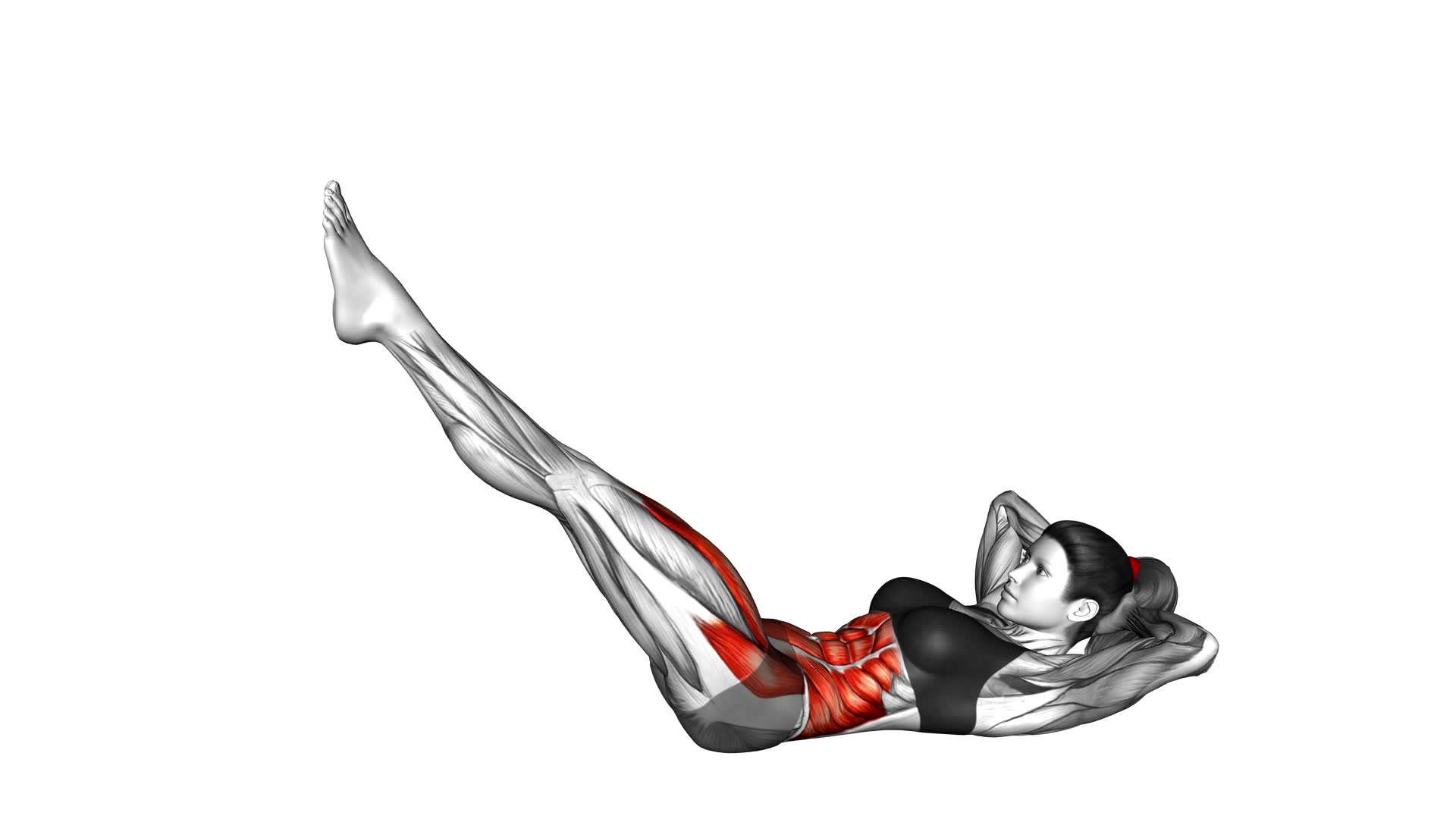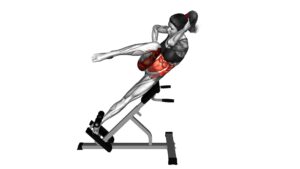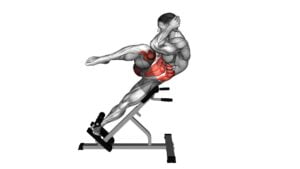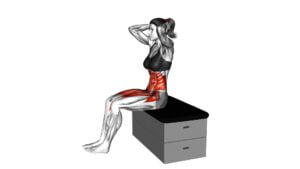Bycicle Twisting Crunch – Video Exercise Guide & Tips

Looking to tone your abs and strengthen your core? Check out our video exercise guide for the Bicycle Twisting Crunch. This intense move targets multiple muscle groups and can be modified to suit your fitness level.
Watch This Exercise Video
Learn the proper form and technique, common mistakes to avoid, and tips to make the exercise more challenging. Whether you're a beginner or have lower back issues, this guide will help you master the Bicycle Twisting Crunch for a stronger, more defined midsection.
Key Takeaways
- The Bicycle Twisting Crunch targets multiple core muscle groups and improves abdominal strength and tone.
- It specifically targets the obliques for improved stability and overall core strength.
- The exercise also enhances flexibility in the spine and hips.
- To make the exercise more challenging, you can increase resistance, try advanced variations, or add extra repetitions.
Benefits of the Bicycle Twisting Crunch
Improve your core strength and flexibility by incorporating the Bicycle Twisting Crunch into your workout routine. This exercise offers numerous health benefits, particularly in terms of abdominal strength. The Bicycle Twisting Crunch targets the muscles in your core, including the rectus abdominis, obliques, and transverse abdominis. By engaging these muscles, you can develop a strong and toned midsection.
One of the main health benefits of the Bicycle Twisting Crunch is its ability to strengthen your abdominal muscles. This exercise specifically targets the obliques, which are responsible for side-to-side movements and rotational motions. By regularly performing the Bicycle Twisting Crunch, you can build up your oblique muscles, leading to improved stability and a reduced risk of injury.
Additionally, this exercise helps to improve your overall core strength. The twisting motion engages multiple muscle groups simultaneously, including the abdominals, lower back, and hip flexors. By strengthening your core, you can enhance your posture, balance, and overall athletic performance.
Incorporating the Bicycle Twisting Crunch into your workout routine can also contribute to improved flexibility. The rotational aspect of this exercise requires a certain degree of flexibility in your spine and hips. Regular practice can help to increase your range of motion and enhance your overall flexibility.
To reap the full benefits of this exercise, aim to perform it correctly and consistently. Start by lying on your back with your knees bent and your hands behind your head. Lift your shoulder blades off the ground and twist your torso while bringing your right elbow towards your left knee. Alternate sides in a bicycle motion while keeping your core engaged throughout the movement.
Proper Form and Technique for the Exercise
To perform the Bicycle Twisting Crunch correctly, you should ensure proper form and technique. Here are some key points to keep in mind:
- Start by lying flat on your back with your knees bent and feet flat on the ground.
- Place your hands behind your head, with your elbows pointing out to the sides.
- Lift your shoulders off the ground, engaging your core muscles.
As you twist, bring your right elbow towards your left knee while extending your right leg straight out. Return to the starting position and repeat on the other side, bringing your left elbow towards your right knee while extending your left leg straight out.
Remember to breathe throughout the exercise and maintain a controlled and steady pace.
By performing the Bicycle Twisting Crunch with proper form and technique, you can effectively target your abdominal muscles and strengthen your core. This exercise is great for improving core strength and stability.
However, if you're looking for alternative exercises to target your abs, you can try exercises such as planks, Russian twists, or mountain climbers. Incorporating a variety of exercises into your routine can help you engage different muscle groups and prevent boredom.
Remember to always listen to your body and consult with a fitness professional if you have any concerns or questions.
Common Mistakes to Avoid While Performing the Bicycle Twisting Crunch
To ensure proper form and technique while performing the Bicycle Twisting Crunch, it's important to be aware of common mistakes to avoid.
One common mistake is lifting the head and neck too forcefully. When performing this exercise, it's crucial to keep the neck relaxed and the head aligned with the spine.
Another mistake is rushing through the movement. To get the most out of the Bicycle Twisting Crunch, it's important to perform the exercise slowly and with control, focusing on engaging the core muscles throughout the movement.
Additionally, it's common for people to let their elbows collapse inward. To maintain proper form, be sure to keep the elbows wide and open, allowing the shoulder blades to stay engaged.
Lastly, avoid using momentum to power through the exercise. Instead, focus on using the abdominal muscles to initiate and control the movement.
Tips to Make the Exercise More Challenging
To make the Bicycle Twisting Crunch exercise more challenging, there are a few tips you can follow.
First, increase the resistance level by using heavier weights or resistance bands.
Second, try advanced variations such as adding a leg lift or performing the exercise on an unstable surface.
Lastly, add extra repetitions to push your muscles further and increase the intensity of the workout.
Increase Resistance Level
To increase the resistance level and make the exercise more challenging, you can add weights or resistance bands to your bicycle twisting crunch routine. Here are some tips to help you increase the intensity and get the most out of your workout:
- Use ankle weights: Strap on some ankle weights to add resistance to your leg movements during the bicycle twist.
- Try resistance bands: Attach a resistance band to a stable anchor and hold the other end in your hands. This will provide resistance as you twist and crunch.
- Increase weight: Hold a dumbbell or a weighted plate against your chest while performing the bicycle twisting crunch.
- Use a weighted vest: Wear a weighted vest to add resistance to your entire body during the exercise.
Try Advanced Variations
To make the bicycle twisting crunch exercise more challenging, you can try incorporating advanced variations. These advanced modifications will help target your core muscles even more effectively.
One option is to hold a weight, such as a dumbbell or a medicine ball, while performing the exercise. This added resistance will require your core to work harder to stabilize your body.
Another advanced variation is to perform the exercise on an unstable surface, such as a stability ball or a Bosu ball. This will engage more muscles in your core as you work to maintain your balance.
Additionally, you can increase the speed and intensity of the exercise by performing it at a faster pace or by adding a twist at the end of each repetition.
These advanced core exercises will challenge your abdominal muscles and help you achieve greater strength and definition.
Add Extra Repetitions
To make the bicycle twisting crunch exercise more challenging, you can add extra repetitions to further engage and strengthen your core muscles. Increasing the number of repetitions in this exercise has several benefits for your core strength:
- Increased muscle endurance: By performing more repetitions, you challenge your core muscles to work harder and for a longer duration, improving their endurance over time.
- Enhanced muscle definition: Adding extra repetitions helps to increase the intensity of the exercise, leading to improved muscle definition in your abs and obliques.
- Improved stability: The bicycle twisting crunch targets multiple muscle groups in your core, including the rectus abdominis and the obliques. The increased repetitions help to improve your core stability and control.
- Calorie burning: Performing more repetitions in this exercise can help to increase your heart rate and burn more calories, aiding in weight loss and overall fitness.
By adding extra repetitions to your bicycle twisting crunches, you'll experience greater challenges and benefits for your core strength.
Now, let's move on to the next section to explore some modifications for beginners or individuals with lower back issues.
Modifications for Beginners or Those With Lower Back Issues
For beginners or individuals with lower back issues, try modifying the Bicycle Twisting Crunch exercise to reduce strain. This modification is also suitable for pregnant women who want to engage their core without putting excessive pressure on their lower back.
To begin, instead of lying flat on your back, prop yourself up slightly by placing a yoga block or a rolled-up towel under your tailbone. This will help alleviate some of the pressure on your lower back and make the exercise more comfortable.
Next, instead of lifting both legs off the ground, keep one foot planted on the floor while you extend the other leg straight out. This will help stabilize your lower back and prevent any excessive strain.
As you twist your torso, focus on engaging your core muscles and maintaining proper form. Avoid any jerky or sudden movements that could lead to injuries. Remember to breathe steadily throughout the exercise to ensure a steady flow of oxygen to your muscles.
Sample Workout Routine Incorporating the Bicycle Twisting Crunch
Here is a sample workout routine that incorporates the Bicycle Twisting Crunch to help you improve your core strength and stability:
- Warm up:
Start with a 5-minute cardio exercise, such as jogging or cycling, to get your blood flowing and muscles warmed up.
- Bicycle Twisting Crunch:
Perform 3 sets of 12 to 15 reps of the Bicycle Twisting Crunch. Lie on your back, lift your legs in a tabletop position, and alternate twisting your torso to touch your elbow to the opposite knee.
- Plank:
Follow the Bicycle Twisting Crunch with a plank exercise. Hold the plank position for 30 seconds to 1 minute, focusing on engaging your core muscles.
- Russian Twists:
Next, incorporate Russian Twists into your routine. Sit on the floor with your feet lifted off the ground, and twist your torso from side to side, touching the floor with your hands. Aim for 3 sets of 12 to 15 reps.
- Cool down:
Finish your workout by stretching your core muscles, such as the lower back and obliques, to prevent any tightness or soreness.
Frequently Asked Questions
How Many Calories Does the Bicycle Twisting Crunch Burn?
The bicycle twisting crunch is an effective exercise for burning calories and toning your abs. By incorporating variations such as adding weights or increasing the speed, you can maximize calorie burn.
To get the most out of this exercise, focus on engaging your core and twisting from your waist. Remember to maintain proper form and breathe throughout the movement.
With consistency and effort, you can achieve great results with the bicycle twisting crunch.
Can the Bicycle Twisting Crunch Help Reduce Belly Fat?
The bicycle twisting crunch is an effective exercise for reducing belly fat. It targets the abdominal muscles and helps to strengthen and tone them.
However, it's important to note that spot reduction isn't possible, and a combination of regular exercise, a balanced diet, and overall weight loss is necessary to reduce belly fat.
If you're looking for alternative exercises to target your midsection, you can try planks, Russian twists, or mountain climbers, which are also effective in reducing belly fat.
Can the Bicycle Twisting Crunch Be Done Without Equipment?
Yes, the bicycle twisting crunch can be done without equipment.
To modify it for beginners, you can start by lying on your back with your knees bent and feet on the floor. Then, place your hands behind your head and lift your shoulder blades off the ground.
As you twist, bring your right elbow towards your left knee and vice versa.
Alternatively, you can try exercises like Russian twists or seated oblique twists for similar benefits.
How Often Should I Do the Bicycle Twisting Crunch to See Results?
To see results from the bicycle twisting crunch, you should do it regularly. The frequency of the exercise depends on your fitness level and goals. Aim to do it at least 2-3 times a week, but you can increase the frequency as you get stronger.
Remember to mix it up and try different variations of the bicycle twisting crunch to target different muscles and keep your workouts challenging.
Consistency is key for seeing results!
Is the Bicycle Twisting Crunch Suitable for All Fitness Levels?
The bicycle twisting crunch is a great exercise that can be suitable for all fitness levels. It targets your abdominal muscles, obliques, and lower back, helping to strengthen and tone your core.
If you find the bicycle twisting crunch to be too challenging, there are alternative exercises you can try, such as the Russian twist or the seated oblique twist.
Incorporating the bicycle twisting crunch into your workout routine can bring numerous benefits, including improved core strength and stability.
Conclusion
In conclusion, the Bicycle Twisting Crunch is a highly effective exercise that targets the abdominal muscles and helps improve core strength. By following proper form and technique, avoiding common mistakes, and incorporating tips to make the exercise more challenging, you can maximize the benefits of this exercise.
Beginners or those with lower back issues can also modify the exercise to suit their needs. Incorporating the Bicycle Twisting Crunch into your workout routine can contribute to a stronger and more toned midsection.

Author
Years ago, the spark of my life’s passion ignited in my mind the moment I stepped into the local gym for the first time. The inaugural bead of perspiration, the initial endeavor, the very first surge of endorphins, and a sense of pride that washed over me post-workout marked the beginning of my deep-seated interest in strength sports, fitness, and sports nutrition. This very curiosity blossomed rapidly into a profound fascination, propelling me to earn a Master’s degree in Physical Education from the Academy of Physical Education in Krakow, followed by a Sports Manager diploma from the Jagiellonian University. My journey of growth led me to gain more specialized qualifications, such as being a certified personal trainer with a focus on sports dietetics, a lifeguard, and an instructor for wellness and corrective gymnastics. Theoretical knowledge paired seamlessly with practical experience, reinforcing my belief that the transformation of individuals under my guidance was also a reflection of my personal growth. This belief holds true even today. Each day, I strive to push the boundaries and explore new realms. These realms gently elevate me to greater heights. The unique combination of passion for my field and the continuous quest for growth fuels my drive to break new ground.







